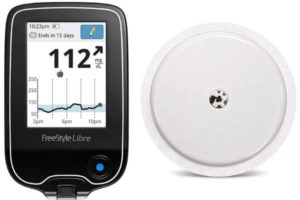Are you a person with diabetes or have a diabetic patient at home? If yes, then a glucometer can be an essential device in your life.
However, with different types of glucometers available in the market, finding one that suits your needs can be a troublesome task. But not anymore!
This article will tell you about the two main types of glucometers: Continuous Glucose Monitors (CGMs) & Blood Glucose Monitors (BGMs) and how they function.
So without wasting a moment, let’s get started!
What Are Glucometers?

A glucometer or a glucose meter is a portable medical device used to monitor blood sugar levels. It comes with strips that test your glucose levels through your blood sample.
Glucose is a sugar that the body uses for energy, and people with diabetes have trouble regulating their glucose levels. Therefore, they need to monitor their glucose levels to get power and prevent various diseases.
Generally, glucometers come in kits that include a battery-powered digital meter, lancets (tiny needles), a lancet device that regulates the depth of the finger stick based on the thickness of the skin, test strips, and tracking software.
The test strips contain a glucose-specific enzyme that responds to the blood sample. Then, the glucometer reads the test strip using electrochemical technology.
Types of Glucometer and they Works
Now that you know how a glucometer works let’s also inform you about its types. Usually, there are two main types of glucometers:
Continuous Glucose Monitors (CGMs)

Continuous glucose monitors track your blood glucose levels automatically all through the day. With a CGM, you can see how your glucose changes within hours or days to see trends.
Watching your glucose levels in real-time may help you make better decisions regarding your diet, medicines, physical activity, etc. To use a CGM, you don’t have to endure the pain of pricking a finger to test your blood sugar levels.
A CGM works via a tiny sensor inserted beneath your skin, especially your belly or arm, for around 7-14 days. This sensor measures the glucose in the fluid between your cells, called interstitial glucose. Then, a transmitter wirelessly transmits the data to a monitor.
The monitor might come as part of an insulin pump or a separate device that you can easily carry in your pocket or handbag. Some CGMs with advanced technology can also deliver data directly to a smartphone.
CGMs are ideal for:
• People who are on tight blood sugar control.
• People who have hypoglycemia unawareness, alerting them to impending low blood sugars.
• People who often have high or low blood glucose.
• All those who are scared of needles, especially young children.
Blood Glucose Monitors (BGMs) & How They Function

Blood Glucose Monitors (BGMs) are single-use blood tests to check blood glucose levels. It functions differently and involves blood sampling. To use a BGM, you have to prick your finger to take a blood sample on a test strip. Then, reading on the screen of a measuring device measures your blood sugar level.
One of the most significant drawbacks of BGMs is that they require test strips and can be painful since each time you test your blood sugar level, you will have to prick your finger to obtain a blood sample.
While BGMs show an accurate glucose level instantly, they don’t give information regarding the changes in glucose levels over time.
However, like CGMs, BGMs also display accurate results. They are easy to use and are also relatively less costly than CGMs.
Moreover, some BGM models have additional benefits, like no test strips and showing results that can be downloaded, etc. BGMs are ideal for people with Type-1 diabetes and those who are not comfortable with sensors.
FAQs
1. Why is my glucometer showing different readings?
If your test strips have been exposed to extreme heat or cold or have expired, they can show inaccurate readings. Moreover, dust, dirt, and other pollutants can also give false readings. Therefore, make sure you use your test strips properly and keep them clean.
2. Can I use the same glucometer strip more than once?
We recommend you not use the same glucometer strip more than once since used/expired strips can give incorrect readings. Therefore, use a new test strip every time you check your readings to get accurate readings.
Conclusion
Having the right glucometer can make a big difference in managing your diabetes. And now that you know about the different types of glucometers and how they work, we hope you will be able to find one that suits your needs the best.
Also, shopping for a glucometer will be much easier for you since we have created a list of the top 10 best glucometers for you to choose from.
If you have any further queries, reach out to us in the comments section below. We will get back to you very soon!


